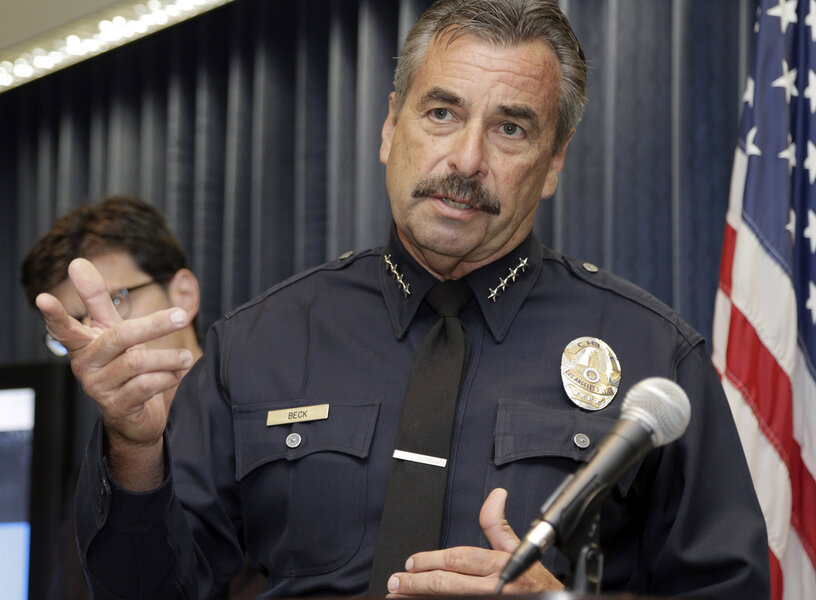LA police shoot suspect in hospital: 20th fatal LAPD shooting in 2015
Loading...
A Los Angeles Police Department officer shot and killed a suspect who, police say became combative and reached for the officer's gun during treatment at the Harbor-UCLA Medical Center on Saturday evening. The suspect was the 20th person shot and killed by LAPD officers this year.
Around 8 AM Saturday, LAPD officers responded to calls of vandalism and fighting in the Harbor Gateway neighborhood, where residents reported a man throwing bottles at a building.
The suspect took a "fighting stance" and reached for officers' guns, department Lieutenant John Jenal told the Los Angeles Times. Officers then used a Taser and a carotid restraint to subdue the suspect. Carotid restraints, or "blood chokes," are a type of neck restraint meant to be safer than chokeholds, which have been banned by many police departments.
The suspect and injured officers were taken to local hospitals, where the suspect was cleared to be taken to jail around 2:30 PM. Police say that, as they unlocked his handcuffs from the hospital gurney, the suspect went "on the attack," attempting to strike officers with a metal stool and to grab an officer's gun.
After Taser shocks did not subdue the suspect, an officer shot him in the torso. He died at the hospital, despite efforts to treat the gunshot wound.
In 2015, on-duty LAPD officers have shot 35 people, including 20 who died. The department, like others around the country, is struggling with public backlash against many of those killings, which are frequently alleged to be racially motivated.
Last week, the department released a report finding that none of the 1,356 complaints of biased policing between 2012 and 2014 had been upheld, which Commissioner Robert Saltzman called "quite troubling and disappointing."
As he told the Los Angeles Times:
While no doubt the vast majority of LAPD officers do not engage in biased policing, it strains credibility to suggest that ... there were zero instances of biased policing. It should not be surprising that there is diminished trust in the LAPD given these results.
As of mid-November, murders in Los Angeles had increased by 12 percent from the previous year, and shootings increased by 20 percent. To combat rising crime, the LAPD has relied on increased officer presence, but also community outreach programs aimed at restoring shaken trust.
Changes include the creation of a "Preservation of Life Medal," for officers who avoided the use of lethal force; the new medal has been sharply criticized by the police union, which says the medal prioritizes the lives of criminals over those of officers.
According to criminologist Charis Kubrin, that lack of trust might contribute to the crime rise in the first place. "If you don't see the police as a viable option when you have a problem, then you handle things on your own," she told the Associated Press.
Hospital-based shootings present an especially difficult dilemma for not only protesters, but medical personnel, some of whom oppose even bringing firearms into a medical facility.
More than 3,000 signed a petition criticizing St. Joseph’s Medical Center in Houston, Texas, where hospital security shot an unarmed patient in the chest in late August. Patient Alan Pean became "combative" after checking himself into the facility, and is facing charges for aggravated assault against an officer who tried to subdue him. Before shooting Mr. Pean, who survived, officers had Tasered him; two officers also suffered injuries.
The petition states:
As doctors and medical students, as nurses and care partners, we are trained in how to safely restrain and tranquilize patients, no matter how aggressive, or irritable, or anxious, or threatening they may be. Never is it appropriate or warranted for a patient to be tazed, never is it appropriate for a patient to be struck, never, never, never is it appropriate for a patient seeking care, to have their life threatened in our arms.
Many doctors point to "Primum non nocere" — First, do no harm — as their guideline for patient restraint. "It is easy for the argument around Alan's case to become preoccupied with the petty questions of what he did or did not do... I think those questions are irrelevant, and a distraction from the real issue at hand," LA-based psychiatry resident Dr. Sonya Shadravan told the Huffington Post.
Some want all officers to leave their guns at the door, partially out of concern that a patient could use them. According to a report from Johns Hopkins, 154 shootings took place on hospital grounds between 2000 and 2011. Eleven percent of those shootings were described as prisoner escape. In eight percent of cases, the perpetrator stole an officer's weapon; in another 16 percent, officers shot the perpetrator.
Other guidelines, such as tips from Campus Safety Magazine, focus on avoiding the factors that could lead to hospital violence when a "forensic patient" is admitted: using rooms with bolted-down furniture, for instance, never leaving the patient unattended, and putting protocols in place for clear officer-to-doctor communication.








